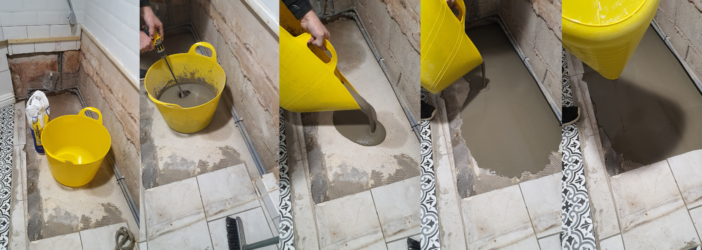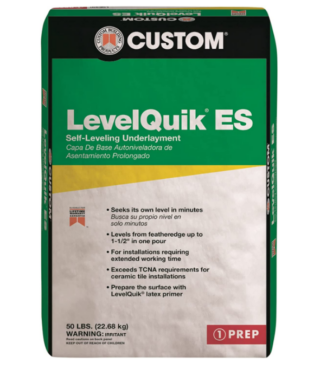If you have an uneven floor to cover, the good news is that there are a number of solutions to level the subfloor surface, so you won’t have to deal with carpet bulges, tile cracks, or wavey linoleum. So, what’s a person to do when faced with the challenge of covering an uneven floor?
I’m married to a joiner (carpenter) and a property developer with more than 25 years of experience and we do all our home renovations ourselves. If you are not a confident DIYer, here are a few options to ask your contractor about:
Self-Leveling Flooring Compound

Self-Leveling Flooring Compound is genius! It’s how we leveled the floor in our bathroom. As you can see, the original floor was tiled only up to the point where the original bathtub stood but we wanted a victorian style free-standing tub, so our new tile had to continue under the tub.
Taking up the original tiles would have been a major nightmare for us, as there was no space for a dumpster outside our Victorian building. We know from experience that it is perfectly okay, in some instances, to tile over tiles. However, this meant that we had to level the concrete area under the tub to the level of the existing tile.
This is where self-leveling compound comes in. It is a type of cement-based mixture that is used to level out uneven surfaces. Depending on the leveler you buy it can be applied over concrete, wood, or other flooring materials and once dry, it provides a smooth, even surface that is ready for almost any type of flooring.
We have used a self-leveling flooring compound on a number of occasions, most recently on a kitchen floor where an addition built way back in the early 1980s didn’t quite meet the floor height of the original house. It worked great and created an even, flat base for our laminate floor.
Just make sure that you choose the right self-leveling flooring compound for the job. For example, if you are putting it on a wooded floor make sure it’s suitable for wooden floors. Read the instructions carefully before use — you may need to prep your floor with primer, etc and you’ll need to work fast as it sets quickly.
I recommend LevelQuik which is suitable on a variety of surfaces including concrete, cement backer boards, RhinoBoard, WonderBoard, exterior grade plywood, ceramic tile, pavers, brick, stone, concrete terrazzo, sheet vinyl, and cutback adhesive.
I was impressed with the easy-to-use formula and relatively long working time. We used an electric mortar paddle mixer and a builder’s tub to mix it in — and just as the product states, it allowed us to apply the product from featheredge to 1 inch thick in just one pour.
Flooring Options for an Uneven Subfloor
Engineered Wood, and Laminate Flooring
Either of the above can be a great option for uneven floors — as long as they are installed with a good underlayment.
Think of engineered wood flooring as a sandwich – it’s made up of multiple layers of wood, with a thin slice of real wood on top and some tasty wood-like fillings in the middle. And just like a good sandwich, this flooring is flexible enough to go with the flow (even if your subfloor isn’t perfectly even). It is also typically more moisture-resistant than solid wood, making it a good choice for use in areas with high humidity or moisture.
Laminate flooring, on the other hand, is made up of layers of composite materials with a high-res image on top that can mimic any natural material your heart desires. They’re tough enough to handle a lot of foot traffic, but they might not hold up as well in a steamy bathroom. Still, laminate floors are a great option for those who want the look of wood without the maintenance.
Depending on which type of flooring you choose and the condition of your subfloor, you will most likely need to use either a wood fiber flooring underlayment or a foam underlay with a moisture barrier. But remember laminate is not as moisture-resistant as engineered wood flooring, so it may not be suitable for use in areas with high humidity or moisture.
Underlayment provides a cushioned layer that is placed between the flooring and the subfloor and this can help to smooth out any imperfections as well as provide additional cushioning, making the floor more comfortable to walk on.
We have used both types of underlayment. The wood fiber boards are thicker so can cover a fair amount of unevenness. However, going the extra mile and laying a concrete (or other) self-leveler will give you the best results.
Another option is to use a plywood underlayment. This is a layer of plywood that is installed over the uneven subfloor, and it provides a smooth, even surface for the wood flooring. The plywood underlayment can be secured to the subfloor using adhesive or screws, and it can help to hide any imperfections in the underlying surface.
Bamboo
Bamboo flooring is the eco-friendly choice that’s tough enough to take on the world (well, most of it at least). It’s a fast-growing, sustainable alternative to traditional hardwood, and it’s just as durable and easy to clean. Plus, bamboo is resistant to moisture and pests, which is always a plus. You can get it in a variety of colors and styles, and you can even install it over concrete or wood. Just keep in mind that bamboo isn’t quite as hard as other wood floorings so it may not be the best choice for high-traffic areas or for use in the kitchen. But if you’re looking to level out an uneven subfloor, bamboo is just as ready for the job as wood or laminate – just be sure to follow the same prep guidelines.
Vinyl
Vinyl flooring is the chameleon of the flooring world – it’s flexible enough to go with the flow (even if your subfloor isn’t perfectly even), and it’s durable enough to handle all the spills and messes life can throw at it. Plus, it’s moisture-resistant and easy to clean, making it a practical choice for all those high-humidity areas in your home. Just be sure to smooth out any major bumps or dents in your subfloor before you lay down the vinyl, and make sure the surface is clean and dry to avoid any adhesive issues. All in all, vinyl is a great choice for uneven floors – as long as you’re willing to do a little prep work.
However, it is important to note that vinyl flooring is not suitable for covering extremely uneven or damaged floors. In these cases, it is necessary to level the floor or repair any damage before installing the vinyl. If the floor is too uneven, the vinyl may not lay flat and may show gaps or wrinkles. It is also important to make sure that the subfloor is clean and dry before installing vinyl, as any moisture or debris can affect the adhesive used to hold the vinyl in place.
To sum up, the results will depend on how uneven the subfloor is. So preparation is key and again, a self-leveling compound may be advisable.
Carpet Tiles
Carpet tiles, made from small squares of carpet, can be easily laid down over an uneven surface. They can be cut to fit around obstacles and can be easily removed and replaced if damaged. Like vinyl, they can be effective with the right preparation (including sanding down raised areas and filling any holes) but success would depend on how uneven the subfloor is to start with.
Cork
Cork is a natural, sustainable material that can be used as flooring. It’s soft, cushioned, and naturally insulating, making it a comfortable and energy-efficient choice. It’s also durable and resistant to water, making it a good choice for wet or damp areas. However, cork is not recommended for areas with heavy foot traffic or for use in kitchens, as it can scratch and dent easily.
Like laminate, cork’s ability to even out a subfloor is heavily dependent on the underlayment used and whether a self-leveling compound is laid.
Conclusion
So, you want to give your uneven floor a makeover? No problem! Just make sure you give it a good prep first. Fill in any gaps or holes, smooth out any bumps, and use a self-leveling compound to create a surface that’s as flat as a pancake. Trust us, it’s worth the extra effort. Then, choose the flooring option that works best for your space and style. With a little elbow grease and some smart choices, you can turn that uneven floor into a thing of beauty.

Leave a Reply